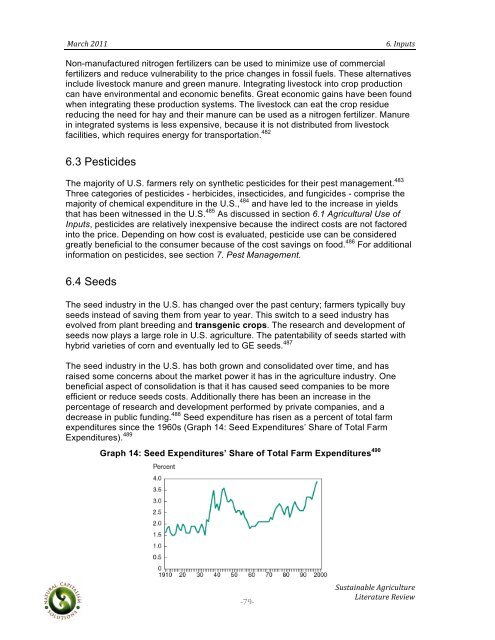Sustainable Agriculture Literature Review - Boulder County
Sustainable Agriculture Literature Review - Boulder County
Sustainable Agriculture Literature Review - Boulder County
You also want an ePaper? Increase the reach of your titles
YUMPU automatically turns print PDFs into web optimized ePapers that Google loves.
! ! !!<br />
"#$%&!'())!! !!!!!!!!!!!!!!!!!!!!!!!!!!!!!!!!!!!!!!!!!!!!!!!!!!!!!!!!!!!!!!!!!!!!!!!!!!!!!!!!!=+!>5?324!<br />
Non-manufactured nitrogen fertilizers can be used to minimize use of commercial<br />
fertilizers and reduce vulnerability to the price changes in fossil fuels. These alternatives<br />
include livestock manure and green manure. Integrating livestock into crop production<br />
can have environmental and economic benefits. Great economic gains have been found<br />
when integrating these production systems. The livestock can eat the crop residue<br />
reducing the need for hay and their manure can be used as a nitrogen fertilizer. Manure<br />
in integrated systems is less expensive, because it is not distributed from livestock<br />
facilities, which requires energy for transportation. 482<br />
6.3 Pesticides<br />
The majority of U.S. farmers rely on synthetic pesticides for their pest management. 483<br />
Three categories of pesticides - herbicides, insecticides, and fungicides - comprise the<br />
majority of chemical expenditure in the U.S., 484 and have led to the increase in yields<br />
that has been witnessed in the U.S. 485 As discussed in section 6.1 Agricultural Use of<br />
Inputs, pesticides are relatively inexpensive because the indirect costs are not factored<br />
into the price. Depending on how cost is evaluated, pesticide use can be considered<br />
greatly beneficial to the consumer because of the cost savings on food. 486 For additional<br />
information on pesticides, see section 7. Pest Management.<br />
6.4 Seeds<br />
The seed industry in the U.S. has changed over the past century; farmers typically buy<br />
seeds instead of saving them from year to year. This switch to a seed industry has<br />
evolved from plant breeding and transgenic crops. The research and development of<br />
seeds now plays a large role in U.S. agriculture. The patentability of seeds started with<br />
hybrid varieties of corn and eventually led to GE seeds. 487<br />
The seed industry in the U.S. has both grown and consolidated over time, and has<br />
raised some concerns about the market power it has in the agriculture industry. One<br />
beneficial aspect of consolidation is that it has caused seed companies to be more<br />
efficient or reduce seeds costs. Additionally there has been an increase in the<br />
percentage of research and development performed by private companies, and a<br />
decrease in public funding. 488 Seed expenditure has risen as a percent of total farm<br />
expenditures since the 1960s (Graph 14: Seed Expenditures’ Share of Total Farm<br />
Expenditures). 489<br />
!<br />
Graph 14: Seed Expenditures’ Share of Total Farm Expenditures 490<br />
"+$"<br />
!,342#.5#6/1!78$.%3/23$1!<br />
9.21$#23$1!:1;.1
















